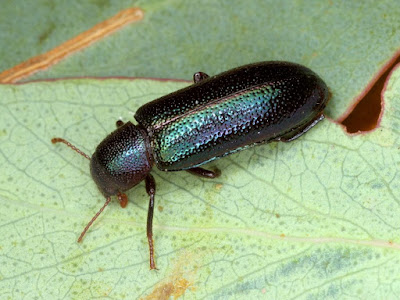Members of the Titaenini have a typical Gondwanan distribution, being known from southern and eastern Australia, New Zealand, New Caledonia and southern South America (Matthews & Bouchard 2008). They grow up to about a centimetre and a half in length with an elongate, parallel-sided body shape that is more or less cylindrical. The prothorax is relatively short, allowing the head to be held vertically in the Australian genus Titaena. Antennae are short with fairly simple segments not forming a club at the end. Legs have similarly simple tarsi. The tribe is distinguished from other, similar darkling beetles by the epipleura (the flattened underside of the elytral margins) which are shortened, not reaching the elytral apex. Members of the Titaenini have large repugnatorial glands opening near the end of the abdomen. In the Australian genus Titaena, at least, species are usually metallic blue or green in coloration.
The habits of the Titaenini are poorly known. As far as we do know, their larvae are specialised feeders on lichen. Adults probably pursue a similar diet. This is an exposed lifestyle, one in which you could easily come to the attention of predators, and the bright coloration of Titaena probably functions to warn off any such unwelcome interest.
REFERENCE
Matthews, E. G., & P. Bouchard. 2008. Tenebrionid Beetles of Australia: Descriptions of tribes, keys to genera, catalogue of species. Australian Biological Resources Study: Canberra.

















Is the tribe old enough that the distribution is really due to vicariance, or did they just "happen" to disperse to ex-Gondwanan places?
ReplyDeleteI can't say. The fossil record for Tenebrionidae as a whole goes back to the Jurassic, which is certainly old enough for genuine Gondwanan distributions.
DeleteThanks
Delete